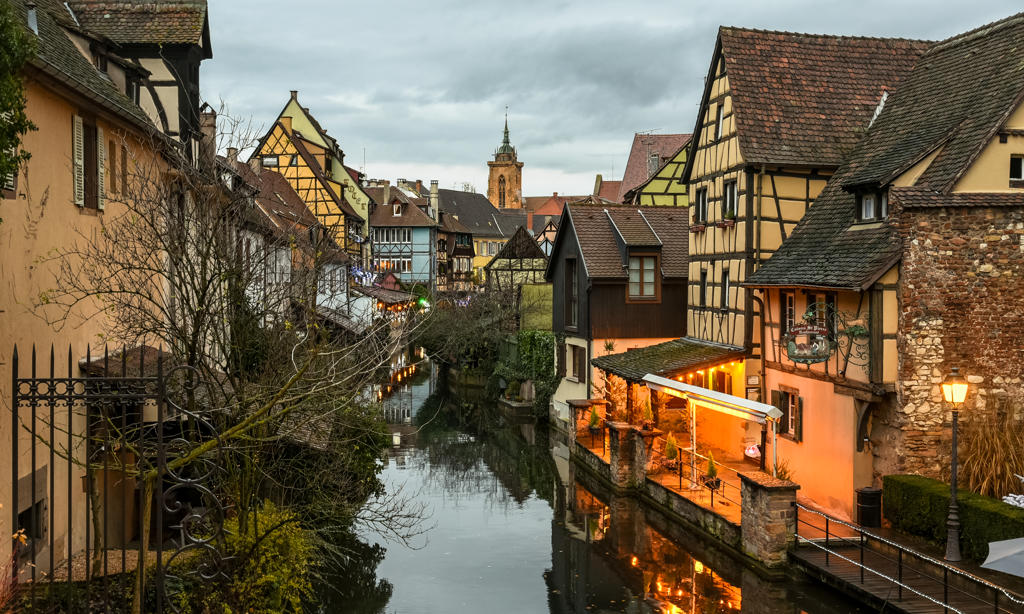About La petite Venise
Colorful half-timbered houses line the canal, their reflections dancing on the water’s surface, creating a picturesque scene reminiscent of a fairy tale. This charming area, known as Petite Venice, is a testament to Colmar’s rich architectural heritage. The vibrant facades, adorned with flower boxes, showcase the Alsatian style, blending German and French influences. The canal, once a vital trade route, now serves as a tranquil pathway for small boats, offering a unique perspective of this enchanting district.
Petite Venice’s history is deeply intertwined with Colmar’s development as a medieval trading hub. The canal system facilitated the transport of goods, contributing to the town’s prosperity. Today, the area retains its historical charm, with buildings dating back to the 16th and 17th centuries. Walking along the cobblestone streets, one can almost hear the echoes of merchants and craftsmen who once thrived here, their legacy preserved in the architecture and layout of the district.
Right Where It Began
The origins of Petite Venice can be traced back to Colmar’s strategic position along the Lauch River, which provided a natural route for trade and commerce. The district’s name, Petite Venice, reflects its resemblance to the famous Italian city, with its network of canals and bridges. This area was historically home to fishermen and boatmen, whose livelihoods depended on the waterways. The preservation of these canals offers a glimpse into the past, where water was the lifeblood of the community.
Plan your perfect trip to Colmar with Travo! Download now and start exploring.
Marks of Time
The architectural details of Petite Venice reveal the passage of time and the influences that have shaped Colmar. The half-timbered houses, with their intricate woodwork and pastel colors, are characteristic of the Alsatian style, reflecting the region’s blend of cultures. Many of these buildings have been carefully restored, maintaining their historical integrity while adapting to modern needs. The stone bridges, arching gracefully over the canals, are enduring symbols of the town’s medieval past.
Stories in Stone
Each building in Petite Venice tells a story, from the Maison des Têtes with its ornate façade to the Pfister House, a masterpiece of Renaissance architecture. These structures are not just homes or businesses; they are living records of Colmar’s history. The carvings and inscriptions found on many buildings offer insights into the lives of their former inhabitants, from wealthy merchants to humble artisans. These stories, etched in stone and wood, connect the present to the past, inviting visitors to explore the rich tapestry of Colmar’s heritage.
Details That Speak
Notice the decorative elements that adorn the buildings, from wrought iron signs to intricate carvings. These details are more than mere embellishments; they are expressions of the town’s artistic spirit and cultural identity. The flower boxes, overflowing with blooms, add a touch of natural beauty, enhancing the charm of the district. Each element, from the cobblestones underfoot to the shutters on the windows, contributes to the unique character of Petite Venice, making it a place where history and beauty coexist harmoniously.
Living History
Today, Petite Venice is a vibrant part of Colmar, attracting visitors from around the world who come to experience its beauty and history. The district is alive with activity, from bustling markets to quiet cafes, where locals and tourists alike gather to enjoy the ambiance. Boat tours along the canal offer a leisurely way to explore the area, providing a different perspective on the historic architecture. As a living testament to Colmar’s past, Petite Venice continues to be a place of inspiration and discovery, where the stories of the past are woven into the fabric of everyday life.

Location
Rue de Turenne, 68000, Colmar





